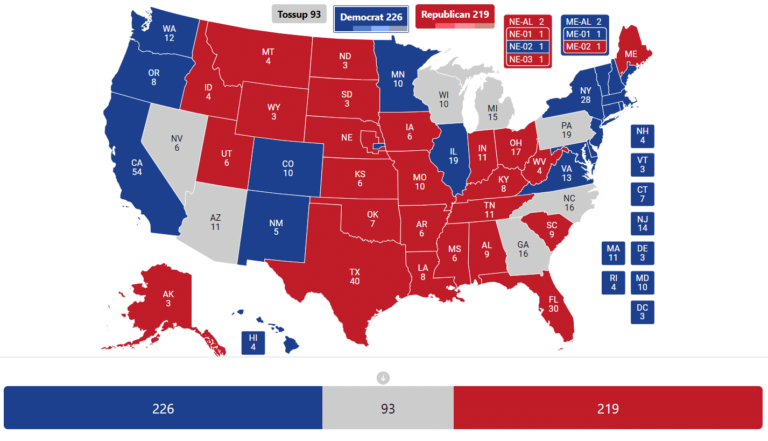Less than two months away now, the 2024 United States presidential election will take place on Tuesday, November 5. Hundreds of millions of Americans will go out to vote and even more people will be watching to see whether Kamala Harris or Donald Trump will win the election and become the 47th President of the United States.
While voters in every state will play a role in electing the next president, all eyes will be focused on the swing states that will be crucial in determining which candidate wins at least 270 electors in the Electoral College, the magic number needed to become president. Both the Kamala Harris and Donald Trump campaigns are spending much time and money in these states, hoping to influence those states’ voters to back them and deliver them their states’ electoral votes to help secure the presidency.
What Swing States Are
Compared to safe states, which are ones that are certain or near-certain to vote for the Democratic or Republican candidate in nearly any scenario, swing states are ones in which both parties’ candidates are competitive and stand a chance of winning their electoral votes. As swing states can reasonably be won by either candidate, they’re always the main focus of candidates’ campaigns, as their electoral votes are the most critical in deciding which candidate claims victory in the Electoral College.
While the states that qualify as swing states can vary from election to election, swing states are generally those that were decided by narrow margins and those that voted for candidates from both parties within the past few presidential elections. The seven most important swing states in the 2024 election are Pennsylvania, Michigan, Wisconsin, Georgia, Arizona, Nevada, and North Carolina. All of them were decided by margins of under 5% in 2020. Five of them (Pennsylvania, Michigan, Wisconsin, Georgia, and Arizona) voted for Donald Trump in 2016 before voting for Joe Biden in 2020. Nevada voted for Hillary Clinton in 2016 and Biden in 2020, while North Carolina voted for Trump twice.
Pennsylvania
For the 2024 election, Pennsylvania has 19 electoral votes, making it the largest electoral prize among these swing states. In 2020, Joe Biden won Pennsylvania over Donald Trump 50.01% to 48.84%, a margin of 1.17%. In 2016, Trump defeated Hillary Clinton in the state 48.18% to 47.46%, a margin of 0.72%. Pennsylvania was one of three Blue Wall states that Trump won in his upset victory over Clinton, and was the tipping point state for the election, meaning that it provided the 270th electoral vote that Trump needed to win the Electoral College.
According to the most recent polling aggregates, Kamala Harris holds a 47.5% to 46.7% lead over Donald Trump in the Keystone State on 538 and a 47.8% to 47.7% lead over Donald Trump on Real Clear Polling. According to The Washington Post, the Harris campaign and its affiliates have focused 20.9% of its advertising spending on Pennsylvania, while the Trump campaign and its affiliates have focused 36.1% of its advertising spending on the state. The Harris campaign most recently visited Pennsylvania on September 13, while the Trump campaign most recently visited on September 10.
Michigan
For the 2024 election, Michigan has 15 electoral votes. In 2020, Joe Biden won Michigan over Donald Trump 50.62% to 47.84%, a margin of 2.78%. In 2016, Trump defeated Hillary Clinton in the state 47.50% to 47.27%, a margin of 0.23%. Michigan was one of three Blue Wall states that Trump won. It was also the closest state in that year’s election.
According to the most recent polling aggregates, Kamala Harris holds a 47.6% to 46.1% lead over Donald Trump in the Wolverine State on 538 and a 48.3% to 47.6% lead over Donald Trump on Real Clear Polling. The Harris campaign has focused 16.1% of its advertising spending on Michigan, while the Trump campaign has focused 11.5% of its advertising spending on the state. The Harris campaign most recently visited Michigan on September 12, while the Trump campaign most recently visited on August 29.
Wisconsin
For the 2024 election, Wisconsin has 10 electoral votes. In 2020, Joe Biden won Wisconsin over Donald Trump 49.45% to 48.82%, a margin of 0.63%. In 2016, Trump defeated Hillary Clinton in the state 47.22% to 46.45%, a margin of 0.77%. Wisconsin was one of three Blue Wall states that Trump won. In 2020, Wisconsin was the tipping point state for the election, providing the 270th electoral vote that Biden needed to win the Electoral College.
According to the most recent polling aggregates, Kamala Harris holds a 48.6% to 45.9% lead over Donald Trump in the Badger State on 538 and a 49.2% to 48.0% lead over Donald Trump on Real Clear Polling. The Harris campaign has focused 9.6% of its advertising spending on Wisconsin, while the Trump campaign has focused 6.8% of its advertising spending on the state. The Harris campaign most recently visited Wisconsin on September 13, while the Trump campaign most recently visited on September 7.
Georgia
For the 2024 election, Georgia has 16 electoral votes. In 2020, Joe Biden won Georgia over Donald Trump 49.47% to 49.24%, a margin of 0.25%. In 2016, Trump defeated Hillary Clinton in the state 50.38% to 45.29%, a margin of 5.09%. Biden’s win in Georgia marked the first time a Democratic presidential candidate won the state since Bill Clinton did so in 1992. Georgia was also the closest state by percentage margin in 2020.
According to the most recent polling aggregates, Donald Trump holds a 47.8% to 47.1% lead over Kamala Harris in the Peach State on 538 and a 48.3% to 48.0% lead over Kamala Harris on Real Clear Polling. The Harris campaign has focused 10.5% of its advertising spending on Georgia, while the Trump campaign has focused 18.6% of its advertising spending on the state. The Harris campaign most recently visited Georgia on August 28, while the Trump campaign most recently visited on August 22.
Arizona
For the 2024 election, Arizona has 11 electoral votes. In 2020, Joe Biden won Arizona over Donald Trump 49.36% to 49.06%, a margin of 0.3%. In 2016, Trump defeated Hillary Clinton in the state 48.08% to 44.58%, a margin of 3.5%. Biden’s win in Arizona marked the first time a Democratic presidential candidate won the state since Bill Clinton did so in 1996. Arizona was also the closest state by popular vote margin in 2020.
According to the most recent polling aggregates, Donald Trump holds a 47.4% to 46.8% lead over Kamala Harris in the Grand Canyon State on 538 and a 48.8% to 47.5% lead over Kamala Harris on Real Clear Polling. The Harris campaign has focused 8.9% of its advertising spending on Arizona, while the Trump campaign has focused 8.4% of its advertising spending on the state. The Harris campaign most recently visited Arizona on September 10, while the Trump campaign most recently visited on September 12.
Nevada
For the 2024 election, Nevada has 6 electoral votes, making it the smallest of the swing states. In 2020, Joe Biden won Nevada over Donald Trump 50.06% to 47.67%, a margin of 2.39%. In 2016, Hillary Clinton defeated Trump in the state 47.92% to 45.50%, a margin of 2.42%. Nevada last voted for a Republican candidate in 2004, when George W. Bush won reelection to a second term over John Kerry.
According to the most recent polling aggregates, Kamala Harris holds a 47.0% to 46.8% lead over Donald Trump in the Silver State on 538 and a 48.2% to 47.3% lead over Donald Trump on Real Clear Polling. The Harris campaign has focused 6.3% of its advertising spending on Nevada, while the Trump campaign has focused 3.4% of its advertising spending on the state. The Harris campaign most recently visited Nevada on September 10, while the Trump campaign most recently visited on September 13.
North Carolina
For the 2024 election, North Carolina has 16 electoral votes. In 2020, Donald Trump won North Carolina over Joe Biden 49.93% to 48.59%, a margin of 1.34%. In 2016, Trump defeated Hillary Clinton in the state 49.83% to 46.17%, a margin of 3.66%. North Carolina last voted for a Democratic candidate in 2008, when Barack Obama defeated John McCain to win his first term as president.
According to the most recent polling aggregates, Donald Trump holds a 47.5% to 47.1% lead over Kamala Harris in the Tar Heel State on 538 and a 48.1% to 48.0% lead over Kamala Harris on Real Clear Polling. The Harris campaign has focused 6.9% of its advertising spending on North Carolina, while the Trump campaign has focused 6% of its advertising spending on the state. The Harris campaign most recently visited North Carolina on September 12, while the Trump campaign most recently visited on September 6.
The Current State Of The Electoral Map
In the 2016 election, Donald Trump won six of these seven swing states (all except Nevada) and defeated Hillary Clinton in the electoral vote 306-232. In the 2020 election, the results were reversed, with Joe Biden winning six of these seven swing states (all except North Carolina) and defeating Donald Trump in the electoral vote 306-232.
Based on the 2024 Consensus map on 270toWin, Kamala Harris is expected to win 226 electoral votes from safe blue states, while Donald Trump is expected to win 219 electoral votes from safe red states. Harris would thus need at least 44 electoral votes from the above swing states to reach or surpass 270 electoral votes, while Trump would need at least 51. By assigning Harris the electoral votes from the swing states where she’s leading in polling and doing the same for Trump, Harris would win the Electoral College 276-262 over Trump and thus the Presidency if the current polling accurately predicted the presidential election results.
There are several caveats to this, however. One is that polls are simply snapshots of how voters are currently feeling at the time and do not necessarily reflect how all voters will vote when it comes time to cast their ballots. Both Harris and Trump will be seeking to influence voters to back them, and voters will be able to change their minds before they cast their ballots.
Likewise, pollsters have had trouble accurately gaging the level of Trump’s support among voters in the previous two presidential elections, underestimating Trump’s support and overestimating Clinton’s and Biden’s support. While many pollsters have made changes to their methodologies to account for potential polling errors, it remains to be seen how accurate the polls will be come election night.
Finally, given how narrow the current margins in each swing state are for both Harris and Trump, either candidate stands a decent chance of winning any of these states. What this all points to is that the 2024 election will likely be a very tight race decided by narrow margins in the key swing states. Only on Election Night will voters be able to tell which candidate assembles the necessary coalition of swing states to win the Presidency.








